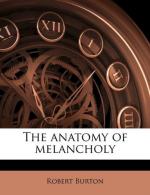c. 3. said, henbane and hellebore were poison;
and Alexander Aphrodiseus, in the preface of his problems,
gave out, that (speaking of hellebore) [4226]"Quails
fed on that which was poison to men.” Galen.
l. 6. Epid. com. 5. Text. 35. confirms
as much: [4227]Constantine the emperor in his
Geoponicks, attributes no other virtue to it, than
to kill mice and rats, flies and mouldwarps, and so
Mizaldus, Nicander of old, Gervinus, Sckenkius, and
some other Neoterics that have written of poisons,
speak of hellebore in a chief place. [4228]Nicholas
Leonicus hath a story of Solon, that besieging, I
know not what city, steeped hellebore in a spring of
water, which by pipes was conveyed into the middle
of the town, and so either poisoned, or else made
them so feeble and weak by purging, that they were
not able to bear arms. Notwithstanding all these
cavils and objections, most of our late writers do
much approve of it. [4229] Gariopontus lib. 1.
cap. 13. Codronchus com. de helleb. Fallopius
lib. de med. purg. simpl. cap. 69. et consil. 15.
Trincavelii, Montanus 239. Frisemelica consil.
14. Hercules de Saxonia, so that it be opportunely
given. Jacobus de Dondis, Agg. Amatus, Lucet.
cent. 66. Godef. Stegius cap. 13.
Hollerius, and all our herbalists subscribe. Fernelius
meth. med. lib. 5. cap. 16. “confesseth
it to be a [4230] terrible purge and hard to take,
yet well given to strong men, and such as have able
bodies.” P. Forestus and Capivaccius forbid
it to be taken in substance, but allow it in decoction
or infusion, both which ways P. Monavius approves above
all others, Epist. 231. Scoltzii, Jacchinus
in 9. Rhasis, commends a receipt of his
own preparing; Penottus another of his chemically prepared,
Evonimus another. Hildesheim spicel. 2. de
mel. hath many examples how it should be used,
with diversity of receipts. Heurnius lib. 7.
prax. med. cap. 14. “calls it an [4231]innocent
medicine howsoever, if it be well prepared.”
The root of it is only in use, which may be kept many
years, and by some given in substance, as by Fallopius
and Brassivola amongst the rest, who [4232]brags that
he was the first that restored it again to its use,
and tells a story how he cured one Melatasta, a madman,
that was thought to be possessed, in the Duke of Ferrara’s
court, with one purge of black hellebore in substance:
the receipt is there to be seen; his excrements were
like ink, [4233]he perfectly healed at once; Vidus
Vidius, a Dutch physician, will not admit of it in
substance, to whom most subscribe, but as before,
in the decoction, infusion, or which is all in all,
in the extract, which he prefers before the rest, and
calls suave medicamentum, a sweet medicine,
an easy, that may be securely given to women, children,
and weaklings. Baracellus, horto geniali,
terms it maximae praestantia medicamentum,
a medicine of great worth and note. Quercetan




